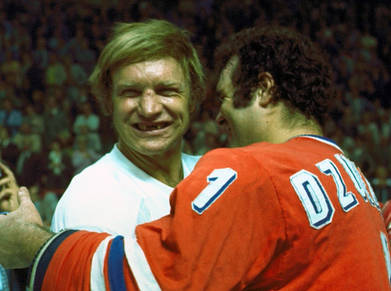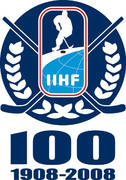Story #6
September 15, 1976 – Montreal, Canada
Although the 1972 Summit Series produced eight extraordinary games and was a huge success, it did little to resolve the dispute between the CAHA (Canadian Amateur Hockey Association) and the IIHF. Canada had withdrawn from international hockey in 1970, and after the Summit Series, it remained inactive until 1977. There was to be one more exception, one that was part of the breakthrough in tension about the use of amateur and professional players in international events.
In 1975, Gunther Sabetzki became IIHF president in place of Bunny Ahearne. He made his number-one priority the resolution to the Canada-IIHF dispute, and one of the central components to this resolution was an agreement by Canada to return to the World Championships and Olympics with the understanding it could use professional players. It was a compromise of sorts because no NHL team would ever simply release a player to play in the Olympics during the season, but the IIHF extended an olive branch by delaying the World Championship until later in the season so NHLers not in the playoffs could represent Canada. In return, the IIHF would endorse a new tournament which featured professionals. Called the Canada Cup, it would be contested first in 1976. It featured six teams, and any team could use whatever players it wanted, regardless of professional or amateur status.
This was the first truly international tournament featuring “best on best” from the best countries in the world. Canada, the Soviet Union, Czechoslovakia, Sweden, Finland, and the United States came to play a round robin series followed by a best-of-three finals between the top two teams in the standings. While it was no surprise to see Canada finish in first place, it was a surprise to see the Soviets in third place and the Czechoslovaks ahead of them to qualify for the finals.
The Czechoslovaks had handed Canada its only loss in the five games of the round robin, a 1-0 decision highlighted by the shutout goaltending of Vladimir Dzurilla. In the finals, however, he wasn’t quite so invincible, and neither was the backup Jiri Holecek. Canada won the first game by a 6-0 score in Toronto, but the second game, in Montreal, was much closer. In fact, Canada had leads of 2-0 and 3-2 in the game, but it needed a late goal by Bill Barber to send the game into overtime.
In the fourth period, Darryl Sittler provided the heroics, faking a slapshot with Dzurilla well above his crease and shooting it in the open net to give Canada the 5-4 win.
Although the win was great publicity for Canada, the tournament proved such a success that it became clear that fans around the world were ready to see the best play the best in a new event. There is a clear line between the series of Canada Cup tournaments that followed – in 1981, 1984, 1987, and 1991 – to the World Cup in 1996 and on to the NHL participation of 1998 and then greater NHL presence at the annual World Championship.
The 1976 Canada Cup proved that Canada had the best team, but like the wakeup call in 1972, it also proved there were several other nations close to the top or able to beat Canada on any particular day. The 1976 Canada Cup was the maturation of international hockey, the event that took international hockey out of a “European” context and into a global context of best on best, the winners crowned, in one sense, true world’s champions.
As part of the IIHF's 100th anniversary celebrations, www.IIHF.com is featuring the 100 top international hockey stories from the past century (1908-2008). Starting now and continuing through the 2008 IIHF World Championships in Canada, we will bring you approximately three stories a week counting down from Number 100 to Number 11.
The Final Top 10 Countdown will be one of the highlights of the IIHF's Centennial Gala Evening in Quebec City on May 17, the day prior to the Gold Medal Game of the 2008 World Championship.
These are the criteria for inclusion on this list: First, the story has to have had a considerable influence on international hockey. Second, it has to have had either a major immediate impact or a long-lasting significance on the game. Third, although it doesn't necessarily have to be about top players, the story does have to pertain to the highest level of play, notably Olympics, World Championships, and the like. The story can be about a single moment — a goal, a great save, a referee's call — or about an historic event of longer duration — a game, series, tournament, or rule change.
|
 |
Click here for the 100 Top Stories
|










